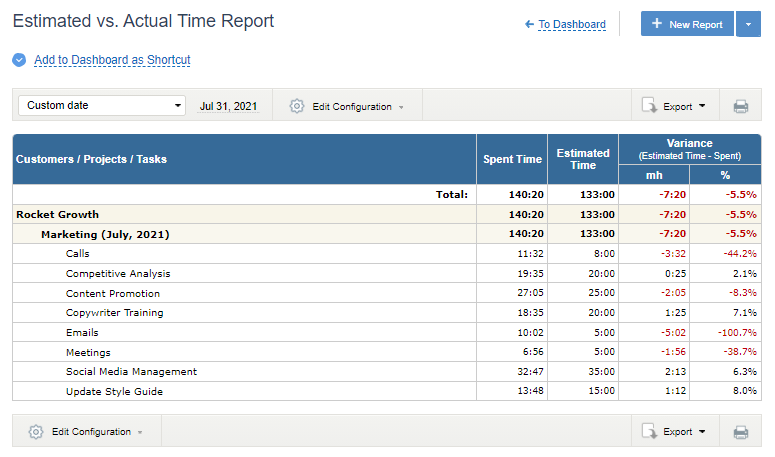
In real life, projects rarely run as planned – it’s a sad but true fact. Failures happen, but they have their positive effects too. They are a source of valuable experience and lessons that help you succeed in the future. In this article, we’ll take a closer look at the reasons for project failures, famous project failures and lessons learned from them, and general recommendations on how to avoid them.
Common Reasons for Project Failures
There are many reasons why projects fail. According to the research conducted by Project Management Institute, the most common reasons for project failures are change in organizational priorities, inaccurate requirements gathering and change in project objectives.
Let’s review some of these reasons in more detail.
8 Reasons Why Projects Fail and How to Avoid Them
1. Poor vision
If a project manager doesn’t have a clear project goal in mind, they won’t be able to define project scope, distribute the resources and keep hold of the project. The most common reasons why managers might have a poor vision of the project are that either they are not competent enough or they need to establish better communication with stakeholders to make sure that you are on the same page.
To avoid it, try this:
- Before you sign the contract, hold a meeting with stakeholders where you could discuss project scope and requirements. After that, create a project plan, check and double-check it, and send it to the stakeholders for approval. If it’s fine, only then sign the contract.
- If you practice the Waterfall approach, consider adopting Agile if it’s applicable to your kind of projects and teams. Agile project management requires high client involvement, meaning that you need to communicate with them at every stage of the project and avoid misunderstanding.
2. Poor communication
A lot has been said about the importance of communication in project management, but interaction between managers and teams, managers and stakeholders and interactions inside the teams are usually far from perfect. According to a PMI survey, ineffective communication is the primary reason for project failures one third of the time. And it’s no wonder: how do you deliver quality results if everyone has their own understanding of the project?
To avoid it, try this:
- Have a communication plan describing the frequency, the channels, the types of communication (calls, meetings, reports) between you as a project manager, the stakeholders and your team.
- Use communication tools to share important news and updates, discuss issues and brainstorm.
- Hold daily meetings to sync your efforts.
3. Wrong estimates
Wrong estimates lead to messed up project plans, frequent and massive changes to the project schedules, budgets overruns and finally, project failures. Some of the most frequent causes of poor estimates is a lack of data-driven approach to project estimation and planning and relying on personal knowledge instead.

To avoid it, try this:
- Implement time tracking software. Upload tasks with estimates and deadlines, get your team to track their time and review the variance between the estimates and the actual hours.
- Discuss current work progress and estimates with your team. For example, if you notice solid time budget overruns, discuss them with your team members, identify reasons and look for solutions to prevent similar mishaps in the future.
- To estimate activities, rely on historical data and take the context into account. Your team is very unlikely to find themselves in the same context that requires exactly the same number of hours to complete an assignment.
4. No risk management
Before you even sign the contract with the stakeholders, you should evaluate the potential risks. Specifically, project managers are responsible for overseeing risks throughout the duration of a given project. Of course, you can’t avoid, prevent or prepare for all of them, but you need to be aware of the most critical ones and have a plan to stick to.
To avoid it, try this:
- Identify risks during interviews with stakeholders and brainstorming sessions with other managers involved.
- Prepare a risk management plan evaluating technical, management, organizational and external risks.
- Prepare and discuss contingency plans with stakeholders and managers involved in the project.
5. Micromanagement
Micromanagement is not the same as thorough control – and its negative effects ruin a team's efforts to deliver a project on time. It invites a lack of trust and destroys the idea of teamwork and collaboration. Besides, it consumes barely affordable amounts of managers' time that otherwise could be spent productively.
To avoid it, try this:
- Never use automated time trackers or employee monitoring tools. If you need to review employee activity levels or the websites they visit, it means only one thing - you are in a poor company. Attract motivated talents, promote trust and see the productivity miracles happen.
- Build a healthy workplace culture. Encourage empathy and communication, knowledge access, process transparency, clarity and fairness.
6. Scope creep
Scope creep brings a lot of chaos into project and team management. Unplanned changes, estimation errors and unexpected delays lead the team to not being able to deliver the agreed scope of work in the required time.
To avoid it, try this:
- Once you have a detailed scope of work, initiate a kick-off meeting with the stakeholders to discuss project scope and risks.
- Make sure you have the scope management part in your project plan and stick to it. Scope management plan describes how the scope of your project will be established and controlled. It usually contains work breakdown structure and a project scope statement.
7. Poor resource allocation
Understaffing and too much work undertaken by the team cause the resource allocation problem: too few people are working on too many projects or tasks at the same time. Not surprisingly, less work is getting done (we all remember the harmful effects of multitasking), and projects eventually fail – not to mention accumulated effects on staff performance and work environment.
To avoid it, try this:
- Identify and track your resources. Use time tracking software to keep track of time, tasks, project costs and manage team members.
- Use absence management software to plan and review employee absences.
- Implement resource management software. Click the link to see our top picks.
8. Poor project monitoring
While it seems to be quite apparent that monitoring and control are important on each project stage, sometimes projects still fail because this type of project work is not performed in the early steps. Proper monitoring helps manage changes, adjust schedules and plans, and prevent scope creep and issues caused by it.
- Use data-based tools for managing projects. Time is the main resource that constitutes project costs and defines the successful project progress. So implement a time and expense tracking solution that monitors project health based on employee input.
- Use project schedules and Kanban boards to review the status of your projects.
9 Famous Project Failures & Lessons Learned
When big projects fail, they end up in news headlines – or sometimes in history books. Their results turn into great lessons for any manager:
- What errors can ruin all the invested effort and should be avoided
- What problems can be anticipated during different project phases
- And how to handle them
Here's a list of several notorious project failures of the past and present times.
1. Edsel by Ford
One of the memorable historical failures is this ambitious project by Ford: a brand-new car named after Henry Ford's son, extensive market research, special production facilities – and resulting high expectations. However, by the time the research was done and the car was presented in 1957, the market already shifted to buying compact cars – which wasn't the case of Edsel.
Lessons learned: With all respect to the importance of thorough research and elaborate development, it's always crucial to remember the speed of market dynamics. Slowing a project down means missing market opportunities.
Note:
"Failure is simply the opportunity to begin again, this time more intelligently," Henry Ford said, and the Edsel failure eventually wasn't a complete loss: production facilities built for it were used for producing the new line of compact cars.
2. DeLorean DMC-12
The famous "Back to the Future" car and one of the best-known project failures: the company and the project of its only car model suffered from various problems long before the first car was produced, and already at the early stages, consultants forecasted a 1-in-10 chance of success. Eventually, this turned into quality issues, enormous delays, and financial problems. In 1982, John DeLorean, the founder, got arrested on drug trafficking charges, and even though he was found not guilty, it was too late.
However, DeLorean seems to be coming back: the new car is announced for early 2019, improving the engine and faster speeds.
Lessons learned: significant uncertainty already at the beginning of the project, poor planning and lack of quality management are not unexpected enemies of project success.
Another lesson: in some cases, leveraging nostalgia and fixing critical problems of the past can bring the project back to life.
3. Microsoft Zune
In the early 2000s, Apple took over the market of portable media players with its iPod, but Microsoft could not just accept this loss. Instead of admitting their defeat, they released their portable player, Zune. The player wasn't a bad product itself – but it was overpriced, Windows-only, and, most importantly, a product designed to chase the competitor. Predictably, it failed and was discontinued.
Lessons learned: sometimes it's better to admit the defeat and find market parts where you can deliver competitive products.
4. Virtual Case File
Virtual Case File, or VCF, was a governmental project of a software application intended to modernize the FBI's outdated IT infrastructure. After five years of development and nearly $170 million consumed, the project was abandoned. The FBI ended up facing strong criticism of the program, as it lost millions of taxpayers' dollars and led to nothing.
Lessons learned: the project suffered from literally all kinds of software development failures: lack of technical architecture, scope creep, micromanagement, code bloat, endless specification changes, and much more. This case shows the importance of careful planning and strictly following the chosen methodology.
5. Apple Lisa
Lisa was the first desktop with a mouse – a technology that eventually took over the market. However, even expensive ads couldn't convince consumers: the product was much less than the campaign promised, and people were not as interested as Apple initially anticipated.
Lessons learned: overpromising is not a way to long-term success. Being not transparent about the capabilities of the delivered product destroys the project.
6. New Coke
"America's taste just got better", – the ads said. After testing the new recipe, Coca-Cola figured out that people preferred the new taste over the traditional one. That was not a surprise: the new product should taste more like Pepsi, to which Coca-Cola was losing ground. New Coke was released. Nothing could go wrong, right? Nope. People didn't buy the new product as expected, and Coca-Cola went back to the traditional formula.
Lessons learned: if it works, don't fix it! There was nothing wrong with the old product, so it was unnecessary to "improve" it.
7. Crystal Pepsi
It's remarkable how healthy food hype influences the "unhealthy" food market. In the early nineties, PepsiCo released the new, "clear" version of their famous soft drink, claiming that it's healthier than the traditional dark soda. We don't know if that was true, but the fact is that people weren't interested in buying it because the flavor wasn't quite right, not to mention that healthy food fans usually don't drink carbonated and artificially flavored beverages.
Lessons learned: bottlers warned PepsiCo that failure is highly possible. David Novak, the COO, later admitted that he learned this lesson: if people are bringing up issues, they might be right.
8. Segway Personal Transporter
What if you have a brilliant idea and a new technology? No, it doesn't necessarily mean that you'll be a pioneer. Maybe your product will be a flop – just like Segway: instead of turning into the next generation transportation, it faded away and was forgotten soon after its debut in 2001.
Lessons learned: if there are serious issues with your product, first detect and fix them. Consumers found Segway too expensive, cities banned it from sidewalks because of speed, and eventually, the product proved to be not viable.
9. Berlin Brandenburg Airport
And, last but not the least. The project of the third Berlin airport is the most recent and relevant example of systematic project failure. Scope creep, unmanaged changes, too many stakeholders with entirely different interests, poor communication – all this turns it into a classic example of how big projects fail.
Lessons learned: all aspects of project management are important, and if several of them are managed poorly or not managed at all, the project is doomed to fail – even if it seems to meet the needs of many.
Preventing Project Failures
Knowing what common failure reasons are, it's easier to identify possible issues in a project. Developing procedures that help avoid failures and mitigate their consequences is an important step of project planning. Here's some advice on how to handle failure risks and what to plan regarding failure risks:
- Make sure your plans, scope and deadlines are realistic. Using previous data can forecast delivery time, work dynamics, and work parts that need extra effort or attention.
- Plan for monitoring procedures on all project steps. Develop or adopt standardized processes for that. The most common reason failures are detected and recognized when it's too late is not monitoring the process properly. However, as risk is an inevitable part of any project, it needs special attention on early steps to be efficiently prevented.
- Use special work management tools to monitor the progress of your project and identify possible risk areas. The data collected by the team provides valuable insights into what parts of the project need close attention.
- Pick a project management methodology that would work best for your particular project, follow its principles, and make sure your team members understand how it works and what roles each of them has in the entire process.
- Communicate. Plan time for communication within the project team, organize meetings (but remember efficient usage of time) and encourage team members to bring up possible issues if they notice them.
- Make sure your team is not understaffed, workloads are reasonably distributed, and individual responsibilities are clear for each team member.
Make sure that long-term goals are visible for your team and everyone understands how the project team is moving towards them.
Summary
It's hardly possible to manage a project without facing any risks, but there are efficient ways to prevent these risks from causing project failures. Following established procedures and methodologies and adapting them to the specific project is a recognized way to handle difficulties and changing environments. And don't forget about learning from previous failures – not necessarily your ones.


















































